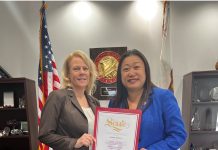
Each time a utility pole topples on Laguna Canyon Road it emphasizes the town’s vulnerability. Residents most often contend with the traffic jam that results from a crash scene under investigation or a downed live wire or the disruption caused by a power outage. Yet the inconvenience of congestion and spoiled goods pales compared to the public safety threat of live wires blocking one of Laguna’s only three escape routes during a disaster or by igniting a wildfire.
Reasons to rid the town of poles and wires go beyond safety. Extracting the poles would not only improve views but also free space on road shoulders to make room for bikes and pedestrians, a requirement of cities under a state mandate known as complete streets.
Next week, the City Council is expected to consider recommendations from experts on how to extract utility poles from streets citywide, an estimated $125 million endeavor.
Just 40 percent of Laguna’s 10,900 electric meters are currently underground, according to a staff report last July on data from Southern California Edison and San Diego Gas and Electric. Some work is paid by utilities with funds required by the California Public Utilities Commission and the rest is paid by individual property owners.
Over the past 25 years, 22 neighborhood assessment districts, comprising 2,200 properties, were created to underground their utilities, costing property owners about $45 million in current year dollars, Public Works Director Steve May said in a report. Staff estimates a $125 million tab to inter the town’s remaining utility lines, excluding those along Laguna Canyon Road, which are covered by a separate program.
Even when funding is secured and an undergrounding project gets the green light, delays by the utilities involved can stretch out completion for years.
Last September, Council members approved the search for an undergrounding expert and a consultant who could offer advice on potential cost savings of acquiring SCE-owned street lights, advice expected to be presented next week.
“It’s big, it’s going to take a long time, it’s going to be very expensive, it’s not easy, but we have to start,” said Council member Steve Dicterow, who first proposed the measure last July with Council member Toni Iseman, thanks to the prodding of Arnold Hano.
One way to accelerate a citywide undergrounding push would rely on bond financing, where a general tax would require a majority vote and a special tax would require approval by two thirds of the electorate. Such a tax might take the form of a sales, parcel or ad valorem tax.
Even if residents approved such a tax, the ensuing process would include a number of hurdles. Easements would be needed for private properties, in some cases requiring eminent domain. Costs of hooking up buildings to below-ground utilities and of upgrading electrical panels, ranging from $2,000 to $10,000, would also have to paid.
If a citywide tax were to be imposed to complete undergrounding, property owners that already paid to put their own poles beneath their feet likely would not have to pay for the undergrounding of other neighborhoods, but contribute to communal projects. So those details would need to be worked out.
To date, most utility poles are removed due to small, neighborhood assessment districts, when a majority of property owners agree to have their properties assessed to pay for the costs of ridding their streets of poles to improve safety and views. This calls for a leader who obtains agreements from 60 percent of the affected owners, who must each contribute a $500 cash deposit. Once approved, the city will front the district the money for assessment engineering and other fees, which will be refunded once the district is assessed for its costs.
Under a PUC stipulation, Laguna Beach receives annual undergrounding allocations of about $100,000 from SCE and $50,000 from SDG&E in South Laguna. The former amount could be consumed indefinitely for undergrounding on Laguna Canyon Road. The area known as Big Bend was funded, but awaits SCE’s action. SDG&E funds are already committed for the next 10 years to a project under design for a portion of Virginia Way in South Laguna.
When a proposed utility assessment district came before the City Council in January, one resident noted that because of the small size of the district, the assessments to each property would be fairly steep. Costs are apportioned based on how much a property will benefit from the removal of poles. She owned the district’s smallest cottage with the lowest property value, but she feared being taxed the most since poles in two separate assessment districts obstructed her views.
“We don’t want to force people out of their homes,” with unaffordable assessments, said Dicterow at that meeting. Mayor Elizabeth Pearson agreed, asking City Attorney Phil Kohn to explore remedies for economic hardship.
Laguna follows in the footsteps of other cities, according to a staff report. Costa Mesa, for example, evaluated options for citywide undergrounding in 2004, but the initiative lacked sufficient community support. Neighborhood assessment districts remain the only option for Costa Mesa residents.
Pasadena established a citywide undergrounding program funded by a 2-percent surtax on electricity use, but it will take 30 years to clear poles from the major roadways and another 40 years to clear all residential streets.





It seems to me the fair way to conduct the undergrounding is to stick with the districts. 60% is not a large majority in a small area. Undergrounding is surly a greater priority in areas of town that have a view.
[…] 40 percent of the town’s 10,900 electric meters are below ground, a staff report says. Some work is paid by utilities with funds required by the California Public […]